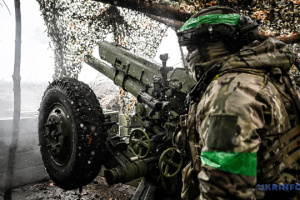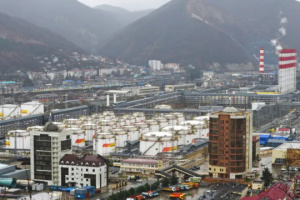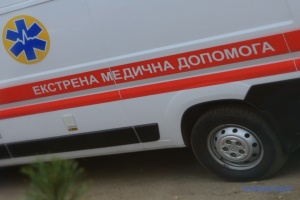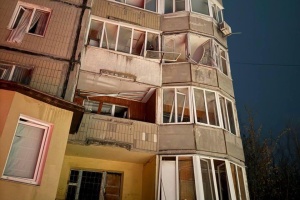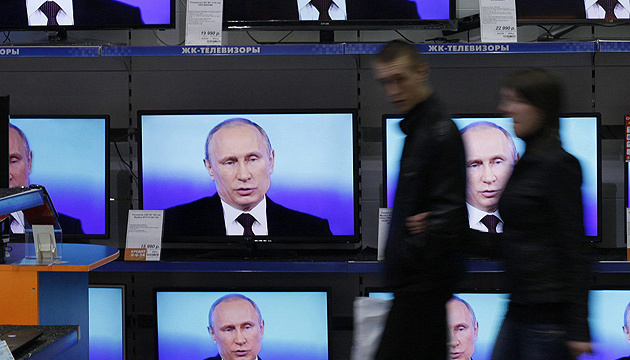
Ten propaganda techniques Russia employed amid aggression against Georgia, Ukraine
By attacking Georgia then, as well as Ukraine now, Russia strongly denied that it was an aggressor. To do this, Moscow invented vague or justifiable names for its invasion. In 2008, it was “Peace Enforcement Operation,” in 2022 — “Special Military Operation.” In both cases, the aggression was explained by caring for the oppressed, Ossetians or residents of the Donbas, who had previously been given Russian passports.
As of August 2008, Georgia no longer controlled most of the territories of Abkhazia and the Ossetian-populated Tskhinvali region (the former South Ossetian Autonomous Oblast). These regions got out of Georgia’s control back during the separatist wars of the early 1990s — not without the help of Russian “hybrid” troops. The situation was somewhat reminiscent of the war in the Donbas and the proclamation of the so-called “DPR” and “LPR” in 2014.
In both cases, Russia pretended to be a mediator and a peacemaker. In both cases, “peacekeeping” ended with an open attack and an interstate war. In Georgia, puppet formations have been waiting for official “recognition” by Moscow for about 15 years. In the Donbas, this process took half the time. In the case of the Ukrainian regions, Russia went even further, proclaiming annexation. Moscow has so far reserved a similar scenario for Abkhazia and the so-called “South Ossetia” for the future; now, this probability is an additional factor of pressure on Tbilisi.
The five-day war of 2008 was the first act of open aggression by Russia against an internationally recognized sovereign country in post-Soviet history. Before that, the Kremlin practiced this in Ichkeria, unrecognized by the international community, declaring the massacre its “internal affair.”
The aggression against Georgia confirmed the seriousness of the revanchist threats made by Putin at the Munich Security Conference in 2007. A few years earlier, the peoples of Georgia and Ukraine had demonstrated their will to finally break with the empire and embark on the European path of development. Peaceful yet well-organized popular demonstrations — the Rose Revolution and the Orange Revolution — quite frightened and angered the Kremlin.
In the perverted imagination of the Putin regime, it was the West that “hybridized” in order to tear its “historical provinces” away from Russia. Therefore, Russia decided to take revenge “symmetrically”: by tearing apart the territories of the rebellious republics. At the same time, Moscow does not see the difference between the imaginary imperial space, “spheres of influence,” whose loss caused phantom pains, and sovereign internationally recognized (including by Russia) territories of states.
Despite a brazen challenge to international law in 2008, Russia, for the most part, got away with attacking Georgia. Encouraged by impunity, the Kremlin chose Ukraine as its next target. In five and a half years, Russia will invade Crimea and the east of Ukraine, disguising itself as “self-defence” and “militias.”
In the war with Georgia, the propaganda brazenness of the Putin regime was fully manifested. Russia was able to impose its narratives on the world. Allegedly Russia was provoked, it is only defending itself, NATO has no right to meddle in the Russian zone of influence. The weak old Russia could have tolerated, but the new Russia will not. Russian troops only protect Russian citizens, the real evil is the troubled and aggressive President Mikheil Saakashvili. The aggression was justified by NATO attacks on Serbia and the subsequent recognition of Kosovo’s independence. Allegedly, Russia does the same, by intervening and recognizing the independence of the separatist territories, although many still had before their eyes the massacre of tens, if not hundreds of thousands of Chechens, carried out by Russia under the slogan of protecting its territorial integrity.
It was the time when Putinism gained strength, charged with ideas of revenge for the defeat of the USSR in the Cold War and for humiliation due to Russia’s begging position in the 1990s.
The Center for Strategic Communication looks into the rhetoric and propaganda techniques of Russia, which were tested in Georgia before being implemented in Ukraine.
“Protecting civilians — citizens of Russia”
Both during the attack on Georgia and during the invasion of Ukraine, Moscow relied on the groups it had created, which it presented to the world as fighters for their own cultural identity and freedom from oppression.
The Ossetians passported by Russia and their “protection” became the pretext for attacks on Georgia far beyond the Tskhinvali region — the oil port in Poti, railway bridges, and interchanges were bombed, and the Russian troops went deep into the territory of Georgia. The Russians also “liberated” Upper Abkhazia controlled by Georgia; no one attacked anyone from there.
Russia’s passportization of the temporarily occupied territories of the east of Ukraine began in 2019. It was reported that more than 600,000 passports had been issued in occupied territories of Donetsk and Luhansk oblasts by 2021.
The fomented Donbas separatism and rhetoric about protecting new citizens of Russia became an excuse for the aggression, unprecedented in the modern history of Europe, in February 2022. As in the case of Ukraine, in Georgia, the scale and goals of Russian aggression went far beyond the declared ones.
Russia’s open attack on Georgia finally clearly showed that Moscow had been misleading the world for decades when it pretended to be a neutral party, a peacemaker. When, in fact, it manipulated Ossetian separatism. Similarly, after an open attack on Ukraine, the true nature of the 2014 conflict was revealed to the world.
Labeling someone as “fascists”
Bohdan Ivchenko, a historian of the Kharkiv Historical Museum, in his 2013 article came to a conclusion that Russian propaganda imposed the image of Georgia as a fascist state on Russian citizens and the world community and compared the conflict with the confrontation between the USSR and Germany during World War II, primarily through television channels.
For example, on August 8, Vice Speaker of the State Duma of Russia Liubov Liska compared Georgian President Mikheil Saakashvili with Hitler: “He is like Hitler, who once attacked sleeping Russia.” LDPR leader Zhirinovsky said that it was necessary to “stop and punish the fascist Saakashvili.”
“A direct comparison of Georgia with the fascist, and even with the Nazi state, was made on August 11 in the news on RTR TV channel. Georgian troops were portrayed only as brutal occupiers. The audience was assured that Georgian soldiers in Tskhinvali were crushing children and the elderly with tanks, pulling people out of the basements and shooting them immediately,” Ivchenko wrote.
Demonizing the enemy
Fictional pictures of Georgian atrocities have become an integral attribute of Russian rhetoric in covering the war.
“Children and the elderly were crushed by tanks, people were burned alive in houses,” Putin lied on August 11, 2008, accusing the Georgian army.
On August 13, on the RTR federal channel, viewers were informed that Georgian tanks were crushing graves in cemeteries, and Georgian soldiers were firing at the church when people were hiding there.
On August 14, Russian Deputy Prime Minister Sergei Ivanov said on the Euronews TV channel that Georgian troops “crushed children with tanks, burned women in sheds.”
On August 17, the program of the NTV channel stated that “Georgian soldiers killed everyone who did not answer them in the Georgian language.”
Propaganda used similar accusations of atrocities against Ukrainians during the attack on Ukraine in 2022, in particular, the burning of Russian prisoners, the carving of Nazi crosses on the body.
Accusations of genocide
“What is happening in South Ossetia is a genocide of the Ossetian people,” Putin said, as reported by RIA Novosti.
On the eve of the full-scale invasion of Ukraine, he also repeatedly lied that there was genocide in the Donbas. “According to our estimates, what is happening in the Donbas today is genocide,” the Russian president said on February 15, 2022, during a press conference with German Chancellor Scholz.
After Scholz dismissed the characterization of the situation in the Donbas as genocide, the Russian Foreign Ministry issued a boorish statement on February 19: “It is not for German leaders to ridicule the issues of genocide. This is unacceptable, given the historical experience of Germany in the issues of mass executions of people and the spread of misanthropic ideology.”
In his speech on February 24, 2022, Putin called the purpose of the “special operation” the protection of people from “abuse and genocide by the Kyiv regime.”
A lie that was confidently repeated multiple times
For mass propaganda, the Putin regime chose the message: “2,000 people were killed in Tskhinvali.” Allegedly, it happened because the Georgians “shelled the city using Grad MRLS.” The phrase about the two thousand killed was repeated by Russian TV channels and official representatives of Russia non-stop. When Russian TV channels were broadcast in Ukraine, their propaganda had an impact on many Ukrainians who believed in “2,000 civilians killed by Saakashvili” and blamed Georgia.
“Two thousand killed, more than 30,000 refugees – isn’t that enough? How many must be killed there for you to recognize it as genocide?!” exclaimed Churkin, Russia’s representative to the UN.
Since 2014, Russia has also been lying about Ukrainians attacking their eastern regions, shelling Donetsk and massacring civilians, which the Russians, the vast majority of them, now believe.
The phrase about 2,000 was also voiced on the American Fox News channel by the Ossetian Laura Tedeeva-Koreviski: “I want you to know whom to blame for this conflict. It was Mr. Saakashvili who started this war, he is the aggressor… and he… for two days, our people, the Ossetians, were killed and bombed, two thousand people were killed in one day.”
Later, propaganda began to claim that witnesses were not allowed to speak on American TV. “As soon as he (the host — clarification) did not like what she said, he began to interrupt her, coughing, wheezing, groaning. He only had to crap his pants, but to do it so clearly that they fell silent,” Putin shared his observations in an interview with CNN.
On August 9, Interfax.ru reported the words of Russia’s Ambassador to Georgia, Vyacheslav Kovalenko, who “stated the fact of the death of at least two thousand residents of Tskhinvali.”
This phrase was coined by propaganda and spread as massively as the words “where were you for 8 years when the Donbas was bombed,” in 2022, which taught Russians to justify an attack on Ukraine.
Later, the report for the EU indicated that the information about 2,000 deaths was not confirmed. “The number of dead and injured on the South Ossetian side turned out to be much lower than originally claimed.” The Investigative Committee of Russia announced the figure of 162 dead civilians a year later — on July 3, 2009.
Here is what the then Georgian authorities told about those events: “Stories that we attacked Tskhinvali from Grad MLRS are a lie. Tskhinvali was bombed by the Russians after we seized it for four and a half hours. We bombed the surrounding heights, using, in particular, aviation and Grad MLRS. I emphasize that we did not bomb settlements,” said the State Minister of Georgia for Reintegration, Temur Yakobashvili.
The ability of the Putin’s regime to lie is evidenced by its current lie about Mariupol, destroyed as a result of the actions of the “Nazis from Azov.” Allegedly, it was the city’s defenders who shelled civilians.
In December 2022, the International Criminal Court completed the investigation phase, which it had been conducting since 2016. As a result, Prosecutor Karim Khan issued an arrest warrant for three suspected representatives of the South Ossetian administration.
Karim Khan noted that these crimes showed a broader picture, “which included large-scale looting and destruction of Georgian villages and houses, as well as the denial of the right to return to almost all Georgians among the population of the Tskhinvali region.” The investigation also revealed the likely role of Vyacheslav Borisov, Major General of the Armed Forces of Russia and Deputy Commander of the Russian Airborne Forces, now deceased, in deliberately facilitating the commission of some of these crimes.
Using provocations as a pretext for war
In the summer of 2008, Russia caused Georgia to send troops into the separatist region, having systematically shelled it from the Ossetia-controlled territory, after which it accused Tbilisi of aggression.
In winter 2022, on the eve of the invasion, the Russians also resorted to provocations, in particular, on February 17, they shelled a kindergarten in Stanytsia Luhanska. On this day, a total of 30 settlements in the territories controlled by Ukraine were shelled. However, the Russians failed to force Ukraine to resort to a radical response.
Then the occupiers announced a mass evacuation of Donetsk residents, which looked awkward because the locals knew that the city was not shelled. Moreover, an irresponsible approach to the creation of “video evidence of Ukrainian attacks” gave the Russians away because the metadata showed that the videos of “Ukrainian provocations” were a year old, and the appeals of the leaders of the “republics” had been recorded in advance.
At the beginning of the war, the cause of its occurrence is important, which becomes the generally accepted explanation, the so-called casus belli — a formal reason. In this context, President Zelensky’s reassuring statement on the eve of the war about “May picnics,” despite all its controversy, contributed to the fact that Ukraine was not perceived as an aggressor in the information field, despite all the Kremlin’s attempts to make it look so. Thanks to the Biden administration’s campaign to publicize Putin’s plans, Russia undoubtedly looked like an aggressor, and it failed to repeat the success of the provocation in Georgia.
“Controlled by the West; puppets the West exploits”
For decades, the Kremlin has accused any country wanting to finally break away from the Moscow empire of venality and lack of independence. Of course, Russia does not like the fact that neighbors and former subordinates are leaving it behind. Not wanting to admit that the reason for such behavior is the internal unattractiveness of Russia, the Kremlin makes up stories, stating that the insidious West breaks the “eternal historical unity.”
Paradoxically, the hateful West was also to blame for the wars unleashed by Russia. Moscow accused Georgia of obtaining American weapons. The war was supposedly beneficial to the United States to ensure the victory in the election of Republican candidate McCain. In the 2000s, the Kremlin regime showed its anti-Americanism with a little shyness because it was afraid to look ridiculous in the eyes of its own citizens. However, the Georgian war was already presented as a consequence of a provocation by the United States. This narrative will be repeated during the Putinist aggression in Ukraine in 2014.
Traditionally, the Kremlin propaganda used African Americans to scare the audience, taking advantage of the everyday xenophobia of the post-Soviet society: “Why are there African American mercenaries in NATO uniforms among the murdered aggressors?” — the question that was asked in the propaganda documentary “War 08.08.08. The Art of Betrayal.” Messages about “black NATO soldiers” were also spread in Ukraine.
Today, 15 years later, we see how the Kremlin is trying to present itself as an opponent of the “hegemony of the West,” a kind of Robin Hood — the creator of a new world order and a multipolar world, and not a bandit — a violator of international law robbing his neighbours. The Kremlin manifests its imperialist aspirations for world domination by hiding them behind a screen of rhetoric about the anti-colonial fight with the West.
Discrediting the president
The standard method of information warfare is personalized attacks on the leader of the country. Saakashvili was ridiculed and discredited as an inadequate and troubled coward who got frightened by the sound of aeroplanes. A similar approach was tried against president Zelenskyy, who was presented as a confused weakling who was preparing to flee Kyiv.
It should be noted that president Zelenskyy, as a former comedian, was much more difficult to ridicule than a politician with a more traditional career path. As a result, Viktor Yanukovych retained the title of president, who fled, not from the Russian army, but from his own people.
“Volunteer participation”
One of the typical news reports on the eve of the war in Georgia: “Don Cossacks are gathering the council in connection with the situation in South Ossetia.” Information about the appearance of battalions of “Cossacks” or other volunteers accompanied each military campaign. It is Moscow’s customary practice in local wars to use, among other things, irregular troops to be able to act on their behalf.
The Kremlin also needed these “volunteers” for the hybrid war in 2014 to present it to the world as a civil war. Thus, the militant Avidzba “Abkhaz” from the “Pyatnashka” group, which fought against Ukraine in the Donbas, had previously fought against Georgia in 2008. This is one of many examples of how the “volunteers” of past wars are used to foment new conflicts in the interests of the Kremlin.
Inciting chauvinism and interethnic enmity
During the conflict with Georgia, Russian criminal chronicles deliberately focused on the Georgian ethnic origin of the attackers. For example, the Georgian mafia was accused of the robbery of cars. Although at the same time, at the official level, statements were voiced that Russia was fighting not with the Georgian people, but with its “criminal authorities.” Similarly, since 2022, the Ukrainians have been accused of drug trafficking on the territory of Russia. Hypocritical statements about friendly feelings towards the Ukrainian people are voiced while destroying Ukrainian-language books and spreading a persistent narrative that Ukrainians as a separate nation should be destroyed, and their children re-educated into Russians.
The chauvinism typical of Russia is characterized by the words of the current political prisoner Navalny: “Of course, I would really like a cruise missile to be launched at the general staff of those rodents, but they are expecting that,” wrote the future opposition politician at the beginning of the Russian invasion of Georgia, although, he later publicly regretted this statement.
Six months after the war, the Olympius Inferno feature film was released, which consolidated the propaganda narratives of Russia regarding the war with Georgia in cinema. After the attack on Ukraine, the Russians continued to shoot propaganda films: “Crimea” (2017), “Opolchenochka” (2019), “Solntsepek” (2021). Currently, a new propaganda film is being shot in Russia, whose scenery in St. Petersburg reproduces the Maidan of 2014. Feature films continue being used by the Kremlin as a field for ideological influence.
In 2008, Russian propaganda portrayed Russia as a superpower with its own legitimate interests. This was one of the most massive Russian propaganda campaigns at the time, which was successful, at least partially. Then there was the seizure of the Ukrainian Crimea, when Moscow again partially managed to impose the idea that “in fact, Crimea has always been Russian,” and that “people rebelled against Ukraine in favour of Russia” in Luhansk and Donetsk.
After the war with Georgia, Russia began to actively build up its “soft power” and propaganda in order to convince Georgians of the correctness of the pro-Russian course.
The current government of Georgia has not supported sanctions against Russia and keeps former President Saakashvili imprisoned in inhumane conditions. “Right now, Russia is killing Ukrainian citizen Mikheil Saakashvili at the hands of the Georgian authorities. We have repeatedly called on the official Tbilisi to stop this abuse and agree to return Saakashvili to Ukraine,” President Zelenskyy said on July 3.
Russian aggression against Saakashvili’s pro-Western and reformist government contributed to his political defeat and the rise of new forces to power. Analysts state that today, Georgia is dependent on pro-Russian forces. In April 2022, the Main Directorate of Intelligence reported that employees of the Georgian special services received instructions from the political leadership not to prevent smuggling through Georgia to sanctioned Russia.
Apparently, the Kremlin dreams of such a “Finlandization” for Ukraine, like it did with Georgia, thinking that over time, it will manage to deceive Ukrainians and bribe them with talks about a mutually beneficial partnership. In the end, not only Georgians, but also once irreconcilable enemies of the Kremlin and fighters for independence — the Chechens — today have overwhelmingly turned into “Putin’s foot soldiers” in the colonial war with Ukraine.
Therefore, it is important to remember the Kremlin’s lies and not to forgive Russian crimes. Only victory can become a reliable guarantee for Ukraine against shame and new enslavement. The Ukrainian victory will also be a victory for Sakartvelo and, perhaps, for Ichkeria as well.
Center for Strategic Communication and Information Security

